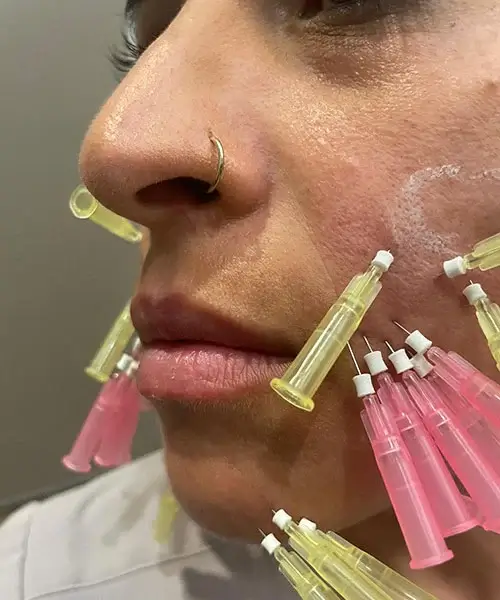Lip Filler Injection: MicroCannula vs. Needle
By Dr. Stephen Cosentino
PRESIDENT OF EMPIRE MEDICAL TRAINING
First-time lip filler patients often brace themselves for multiple sharp needle pricks during their 15-to-30-minute treatment session. Yet, many are pleasantly surprised to find the experience more comfortable than anticipated. This shift in patient experience is mainly due to the increasing adoption of a newer microcannula lip filler injection technique.
While the microcannula technique isn't a huge departure from the traditional needle approach, research indicates that it may reduce the risk of local side effects and more serious complications. If you're thinking about lip fillers, it's a good idea to understand the key differences between needles and cannulas.
Understanding Microcannulas and Traditional Needles
Microcannulas: The New Age of Lip Fillers
A microcannula can be thought of as a blunt-tipped polymer needle that's more flexible than a traditional hypodermic needle. Key characteristics include:
- Narrower and longer than traditional needles
- Designed to flex under pressure, reducing the risk of breakage
- A blunt tip that appears sharp to the naked eye
- Ability to deliver filler in a precise treatment area, not necessarily in a straight line from the entry point
Traditional Needles: The Conventional Approach
Traditional needles used for lip fillers have the following characteristics:
- Very sharp tip designed for easy skin penetration
- Thicker than a microcannula, but still very narrow
- Straight, rigid trunk for precise filler delivery to specific areas
- May cause more discomfort during injection
The Advantages of Microcannula Lip Filler
Many patients and providers prefer microcannula lip filler injections for several reasons:
1. Reduced Bruising and Swelling
The blunt tip of a microcannula is less likely to puncture blood vessels, leading to a significant reduction in bruising and swelling post-treatment. This means patients can potentially return to their normal activities sooner.
2. Enhanced Comfort During Treatment
Microcannulas generally cause less discomfort during the injection process. The flexible nature of the cannula allows for smoother movement under the skin, resulting in a more pleasant experience for the patient.
3. Decreased Risk of Vascular Occlusion
One of the most serious complications of dermal filler injections is vascular occlusion, where filler material blocks a blood vessel. The blunt tip of a microcannula is less likely to enter a blood vessel, thereby reducing this risk.
4. Fewer Injection Points
With a microcannula, providers can cover a larger area from a single entry point. This means fewer punctures in the skin, contributing to reduced trauma and a faster recovery time.
5. More Even Distribution of Filler
The flexibility of microcannulas allows for smoother, more even distribution of filler material. This can result in more natural-looking outcomes and potentially longer-lasting results.
Considerations When Choosing Between Microcannulas and Needles
While microcannulas offer numerous advantages, traditional needles still have their place in lip filler procedures. Here are some factors to consider:
1. Treatment Area
Microcannulas are particularly beneficial for larger treatment areas or areas requiring more volume. For very precise, small-area treatments, traditional needles may still be preferred.
3. Provider Skill and Preference
The effectiveness of either technique largely depends on the skill and experience of the provider. Some practitioners may be more comfortable and proficient with one method over the other.
3. Patient Anatomy
Individual patient factors, such as lip shape, skin thickness, and the presence of scar tissue, may influence the choice between microcannulas and needles.
The Importance of Choosing a Qualified Provider
Regardless of whether you opt for a traditional needle or a blunt-tipped cannula for your lip filler injection, the most critical decision is your choice of provider. It's essential to work with a board-certified plastic surgeon or other medical professional who has completed an accredited dermal fillers training course.
Your provider's expertise will have a far greater impact on your treatment outcome and safety than the choice of injection device. They will be able to:
- Assess your individual needs and anatomy
- Choose the most appropriate technique and product
- Minimize the risk of complications
- Handle any potential adverse events effectively
The Risks of DIY or Unqualified Injections
It's imperative to avoid attempts at self-injection or seeking treatment from unqualified individuals, even if it seems more cost-effective. The risks associated with these practices far outweigh any potential savings:
- Increased risk of infection
- Higher likelihood of asymmetry or undesired results
- Greater chance of serious complications, including vascular occlusion
- Potential use of counterfeit or substandard products
Furthermore, buying botox or fillers online for personal use is extremely dangerous. These products may be counterfeit, contaminated, or contain unknown substances that could cause severe harm.
Kiss Goodbye
The introduction of microcannula lip filler techniques represents a significant advancement in the field of facial aesthetics. While it offers numerous benefits, including reduced bruising, enhanced comfort, and potentially safer outcomes, the choice between microcannulas and traditional needles should be made in consultation with a qualified provider.
Remember, the key to a successful lip filler treatment lies not just in the tools used, but in the hands that wield them. Always prioritize working with a board-certified professional who has undergone comprehensive training in dermal filler techniques. Your safety and satisfaction depend on it.


